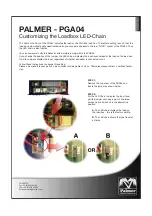
M9B-HFS INTERFACE
MAINTENANCE
Release 1.0 (97/10)
5-1
5.
MAINTENANCE
5.1 Introduction
This section describes the diagnostic LEDs located on the M9B-HFS interface printed circuit board (PCB) and
provides a list of replacement parts for the interface. The schematic for the M9B-HFS interface is in Appendix
B.
5.2 Troubleshooting
5.2.1
Diagnostic LEDs
Computer Operating Properly (COP) LEDs
There are three diagnostic LEDs, located at CR164, CR163, and CR97 on the M9B-HFS interface PCB. Refer to
Figure 2.7-1 for their locations. Issue a RST (reset) command to clear diagnostic LEDs.
When it lights up, the green COP LED at circuit designation CR164 indicates that the M9B-HFS interface
microprocessor successfully recovered from a timeout error due to a communications bus error. The event is
transparent to the M9B-HFS line. The M9B-HFS interface continues to function normally.
A lighted, red COP LED at CR163 indicates that noise in the master processor circuitry caused a transparent
restart. An internal bus error will also attempt a transparent restart.
A lighted, red COP LED at CR97 indicates that noise in the slave processor circuitry caused a transparent restart.
An internal bus error will also attempt a transparent restart.
5.3 Replaceable Parts
WARNING
Exercise caution when using and servicing power supplies. High energy
levels can be stored at the output voltage terminals on all power supplies
in normal operation. In addition, potentially lethal voltages exist in the
power circuit and the output connector of power supplies which are rated at
40V and over. Filter capacitors store potentially dangerous energy for some
time after power is removed.
CAUTION
Use proper static control techniques to avoid damage to static-sensitive
components on the printed circuit board.
In this section, you will find parts lists for the M9B-HFS Interface assembly. Each of the parts and options listed
can be ordered separately.
5.3.1
Parts Replacement and Modifications
Do not use substitute parts or make any unauthorized modifications to the interface to ensure that its safety
features are not degraded.










































